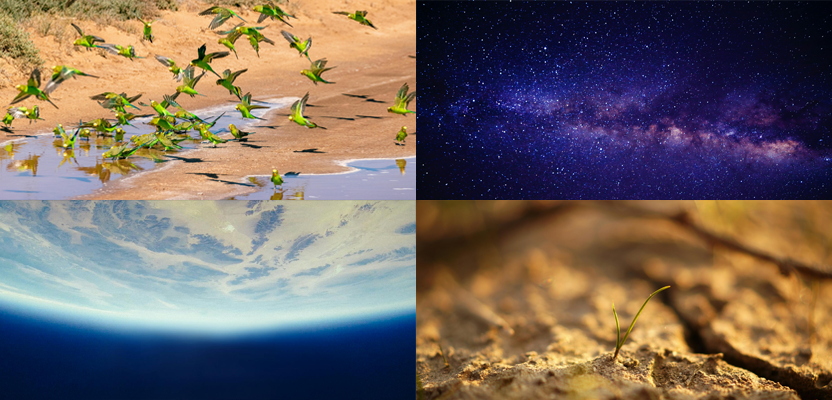Populations of four native mammal species – bilbies, crest-tailed mulgaras, Shark Bay bandicoots and golden bandicoots – are booming since their recent reintroduction to Sturt ³Ô¹ÏÍøÕ¾ Park in the far-west NSW outback.
These mammals were translocated to the area between 2020 and 2022 as part of the NSW Government’s , with the Sturt ³Ô¹ÏÍøÕ¾ Park site managed by UNSW Wild Deserts, aiming to revitalise the desert landscape by repopulating the park with small native mammals. The project is run in collaboration with Ecological Horizons, NSW ³Ô¹ÏÍøÕ¾ Parks and Wildlife Service, and Taronga Conservation Society.
Up until recently, bilbies, mulgaras and the Shark Bay bandicoots were locally extinct in the region – but annual trapping survey results show the conservation work is paying off.
“The crest-tailed mulgara populations have rocketed up to between 160 and 240 individuals,” says Dr Reece Pedler, Wild Deserts project coordinator. “We originally only started with 19, translocated from wild populations in South Australia in August 2020.
“Given each female can have up to eight young and conditions have been booming from rainfall in early 2021 and again in January this year, it has been the perfect for mulgaras to grow their population.”
Crest-tailed mulgaras were the first mammals to be reintroduced to Wild Deserts, but bilbies – who were reintroduced shortly after – are already increasing their numbers, too.
“It’s now estimated up to 60 bilbies are bouncing around the feral predator-free areas, including female bilbies bred at Wild Deserts, which are now having pouch young of their own,” says Wild Deserts principal ecologist, Dr Rebecca West.
“It is really the icing on the cake to find new female bilbies that are also breeding.”
NSW Environment Minister James Griffin said it’s great news for the NSW Government’s world-leading rewilding program.
“We set out a bold plan backed by science to create areas where we could eradicate feral predators and reintroduce locally extinct animals like the bilby and numbat, which have been extinct in the wild in NSW for more than 100 years,” Mr Griffin said.
“The Sturt ³Ô¹ÏÍøÕ¾ Park sites is part of our world-leading program of rewilding, with a goal of returning the bush to how it was before feral animals were introduced 200 years ago. It involves strong partnerships between the ³Ô¹ÏÍøÕ¾ Parks and Wildlife Service, UNSW Wild Deserts and Taronga Conservation Society Australia.
“It’s incredible to see that in such a short period of time, we’re on track to remove at least 10 animals from the NSW extinct list – the first time this will have happened anywhere in the world.”
The bilby population has grown from an initial group of 10 greater bilbies reintroduced from Taronga Western Plains Zoo in September 2020, followed by another 30 bilbies in May 2021 from South Australian populations at Arid Recovery and Thistle Island.
Dr West says the 13 Shark Bay bandicoots translocated from Arid Recovery last May haven’t wasted time either – their population is estimated to have doubled only six months after they were released.
Even though female bandicoots can only have two young in their pouch at once, all of the six females translocated have already had two litters each since arriving at Wild Deserts.
“It was fantastic to catch new young bandicoots so soon after the translocation,” says Dr West. “It’s a great indicator of the project’s success so far.”
Up until recently, Shark Bay bandicoots were one of five bandicoot species known as western barred bandicoots, a species that roamed around Sturt ³Ô¹ÏÍøÕ¾ Park 100 years ago. Recent taxonomic work has split them into five species, and only the Shark Bay bandicoots – the species translocated to Sturt ³Ô¹ÏÍøÕ¾ Park – survived on offshore islands in Western Australia.
“These results are so important for the long-term goal of restoring this magnificent desert ecosystem back to something like it once was,” says UNSW Professor Richard Kingsford, Wild Deserts project lead.
“It’s wonderful to see these animals back in their original home and many of the other parts of the environment responding, prospering and restoring this desert ecosystem to some of its past magnificence.
“Every year’s results are exciting. We are looking to transform this environment out here by putting these animals back in and establishing food webs that were once here.”
The most recent species to be reintroduced from Western Australia, the golden bandicoot (27 individuals), even though arriving only in May are thriving. At the point of translocation, only one of the females had pouch young and these are now independent, with the latest data indicating that most females now have pouch young.
Not only are these locally introduced species doing well, the environment is booming. The team compiled their information from regular ecological monitoring surveys conducted throughout the year, which monitor how the animals have been faring.
While the team don’t catch every mammal, they use trapping data and modelling to estimate the size of each of the translocated populations.
“These trapping and track monitoring surveys give us a great insight into the status of not only each of our translocated populations but also the whole environment” says Dr West.
“During our 2022 surveys, we had nearly double the small mammal capture rate inside the feral-predator free areas compared to outside in Sturt ³Ô¹ÏÍøÕ¾ Park, including 108 dusky hopping mice and 8 plains mice, both threatened species.”
It is now one of the largest, feral-animal-free areas in Australia, with the partnership of NPWS and UNSW Wild Deserts project team eradicating every last rabbit, cat and fox from two 2000 hectare feral-predator free fenced areas.
–








